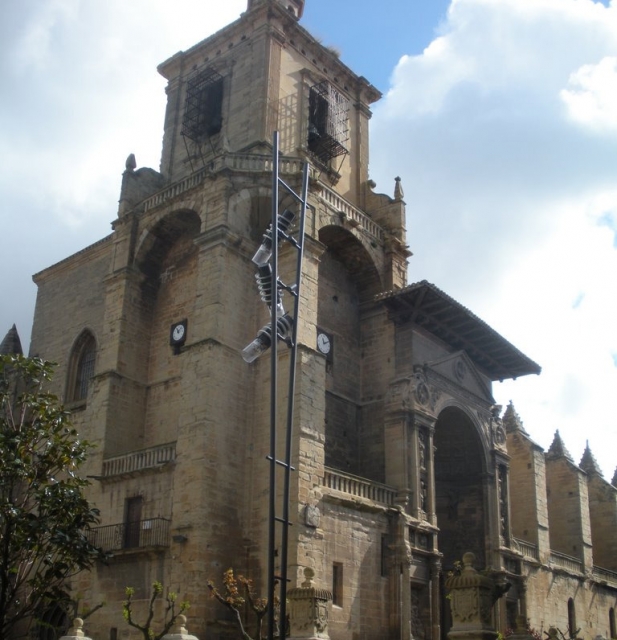What to see in Viana
The zigzag urban route leads the walkers to Viana through the streets Calle el Cristo and La Pila. The monumental centre is accessed through the Portal de la Trinidad, the ancient walls, were built in the XVII century to facilitate the trade of goods.
The site borders the former Kingdom of Castile and consequently Viana became a military stronghold in the form of a fortress. From the XIII century a castle was erected and walls were constructed, with towers and four gates situated at the four cardinal points. Located to the west is that of San Felices, situated where the first stone of Viana was placed, in 1219.
Later, in the XVII those of Trinity and San Miguel were constructed. The Jacobean route continues down the street Calle Algarrada, which preserves examples of Renaissance mansions, to reach, immediately after the square, Plaza del Coso, where bullfighting celebrations took place. Here hikers can see the Balcon de Toros, a XVII century baroque palace constructed as the Royal viewing Box for the municipal authorities who presided the previously mentioned bullfighting celebrations.
The next Jacobean Street on Rúa de Santa Maria is the famous Calle Mayor of the enclave, with its medieval houses adorned by decorative elements and numerous services to pilgrims. In this place, and after advancing a few meters there stands the monumental church of Santa María, declared a National Monument in 1931. A gothic construction from the XIII century, inside the magnificent baroque altarpiece and paintings by Luis Paret that decorate the chapel of San Juan del Ramo stand out. Outside, at the foot of the Renaissance style south portal there is a marble slab to remind visitors that here lies the tomb of César Borgia.
The son of Pope Alexander VI became the Bishop of Pamplona at the age of 16. Destined to become Pope, a year later he was ordained cardinal, allowing him to enter the Vatican curia, shared by the likes of Leonardo da Vinci and Machiavelli. Appointed General Captain of the Papal troops his military career was cut short by the appointment of Pope Julius II, whom ordered his capture and imprisonment in the Vatican.
Once released he escaped to Spain where his brother in law King Juan of Navarre appointed him as captain of the armies of Navarra. He died in a battle in Viana on March 11th in 1507. Known as a restless adventurer, he divided his life between study, battles and Vatican diplomacy. Another monument, located in the Plaza Sor Simona, next to the baroque Convent of San Francisco, was erected in memory of this key character of the Renaissance period. At the foot of the temple lies the Plaza de los Fueros and, opposite, the elegant XVIII century town hall with a French Baroque facade.
Its main meeting room contains a statue of the torso of Mary Magdalene, patron of the enclave and, in the municipal archive, the Fuero del Privilegio del Águila, historical papers that confirm that Sancho VII founded the town in 1219. The route then proceeds down Calle Navarro Villoslada, where the Casa de Cultura is located, it occupies a fifteenth century building which previously served as a hospital for pilgrims, and leads to the Plaza de San Pedro, which preserves the church and fortress of San Pedro.
This thirteenth-century Gothic building is the oldest preserved building in the town. Its privileged, defensive location meant it was used as a headquarters by Napoleonic troops and by both sides in the Carlist Wars. But its unstable construction, on an escarpment caused a part of its structure to sink in 1844. In the old cemetery the best parts of the wall have been conserved.
Furthermore, from here there is a fantastic view of the valley of Ebro. Visits in the surrounding area The oldest monument in Viana is situated nine kilometres north of the centre. The building, Hipogeo de Longar is a megalithic burial chamber located on the famous mount Alto de los Bojes, dated between 2850 and 2500 BC, and discovered in 1985, it is accessed through an opening in the stone slab. Inside they found 80 skeletons and distinct flint tools. From Viana there is a path that reaches the monument it is taken from the fountain Fuente Vieja.
Points of interest of Viana (1)
23°
27/07/2024
cielo despejado

- Connection by bus
- Cash machine
- Pharmacies
- Supermarkets
- Taxi stops
Routes
Blog
 How to get to Sarria to do the Camino de Santiago
How to get to Sarria to do the Camino de Santiago
 Descubre la magia del Camino de Santiago Portugués por la costa
Descubre la magia del Camino de Santiago Portugués por la costa
 5 tours culturales que puedes hacer en Galicia si decides hacer un alto en el camino
5 tours culturales que puedes hacer en Galicia si decides hacer un alto en el camino
 Doing the Camino de Santiago in June: What you should know?
Doing the Camino de Santiago in June: What you should know?
Information
Points of interest
Cities & Towns | Hostels | Lodgings | Restaurants | Saddlery | Doctors | Points of interest | Bikes workshop
Contact us | Privacy policy | Cookies policy | | Terms of use | Authorship | Web Map | Consentimiento
© Copyright LA VOZ DE GALICIA S.A. Polígono de Sabón, Arteixo, A CORUÑA (ESPAÑA) Inscrita en el Registro Mercantil de A Coruña en el Tomo 2438 del Archivo, Sección General, a los folios 91 y siguientes, hoja C-2141. CIF: A-15000649
Developed and managed byHyliacom
